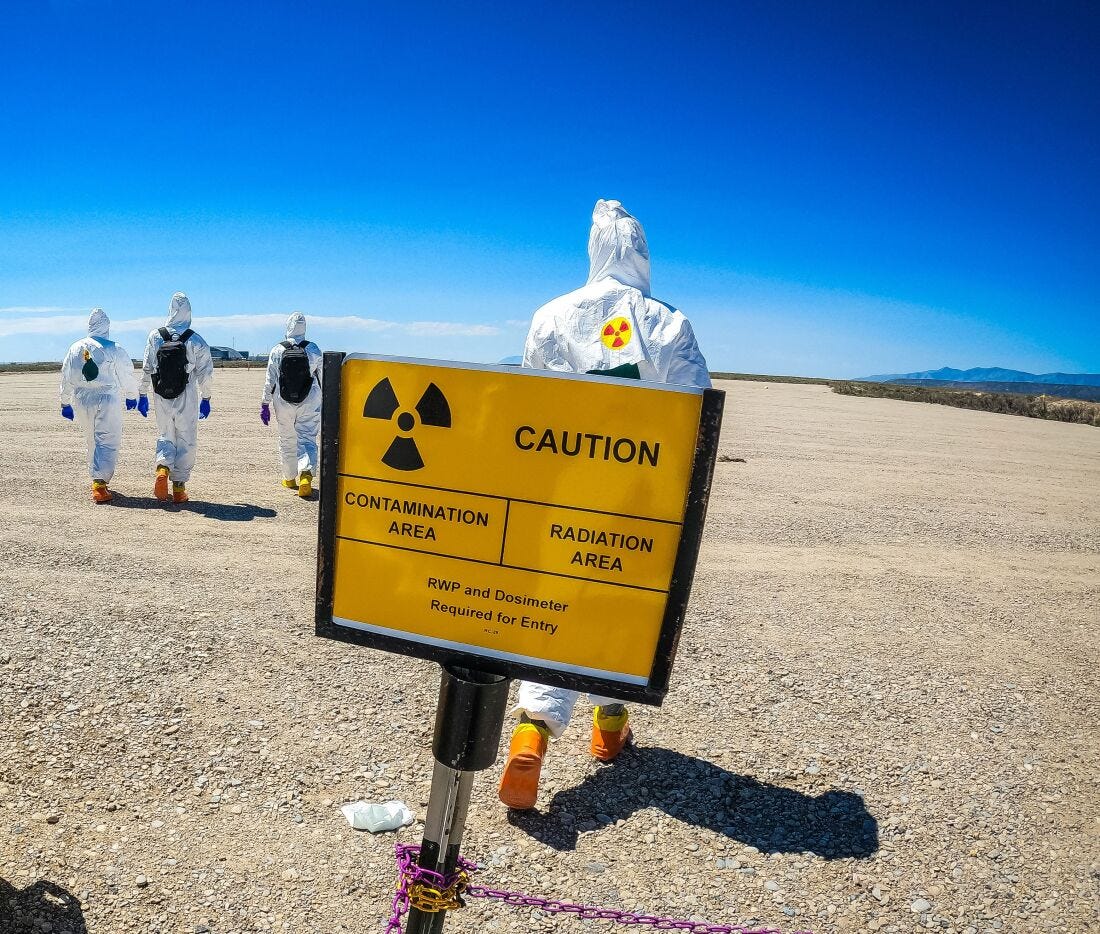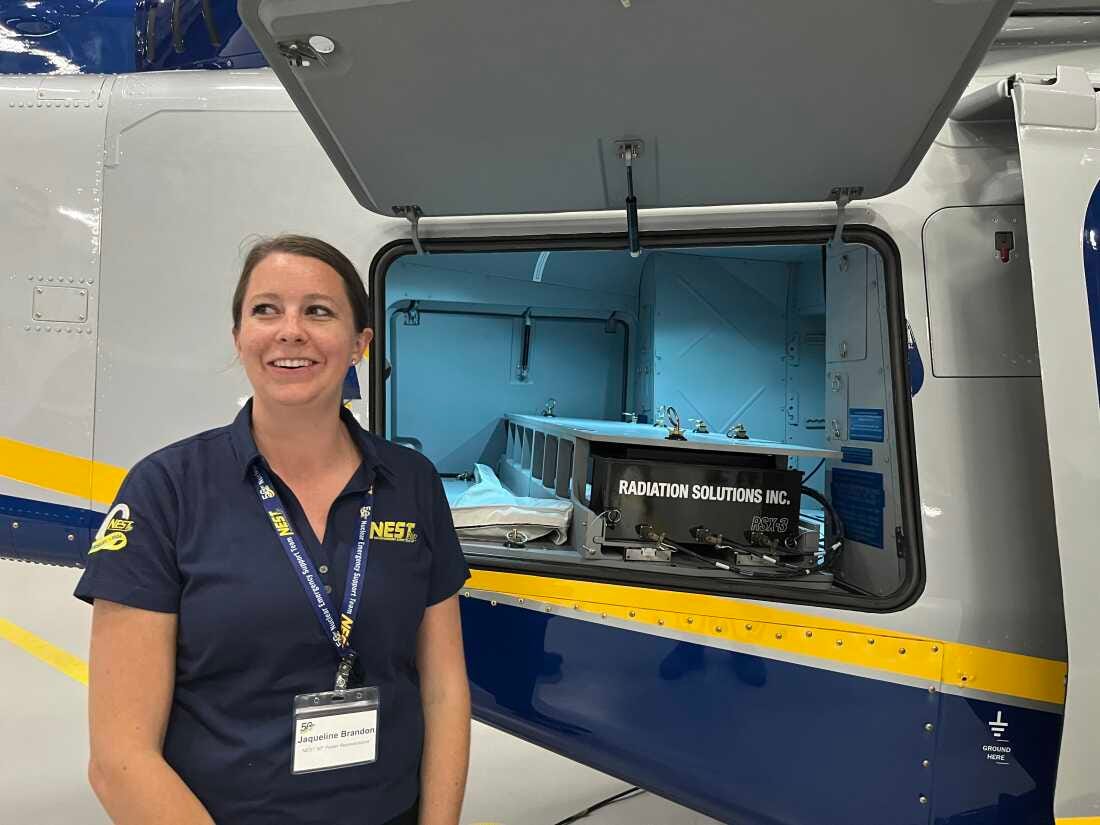LLAW’s All Things Nuclear #795, Tuesday, (10/29/2024)
"End Nuclear Insanity Before Nuclear Insanity Ends Humanity” ~llaw
A NEST AgustaWestland 139 helicopter equipped with special radiation monitoring equipment on display during the team's 50th anniversary celebration at Joint Base Andrews. The helicopters, which measure radiation by flying low and slowly, are deliberately painted with a civilian color scheme to avoid the "black helicopter" stereotype.
LLAW’s NUCLEAR VIEWS, ISSUES & COMMENTS, Tuesday, (10/29/2024)
In addition to the following article on secret nuclear health and safety investigations, there is another story in today’s blog that will emphasize that this job will become an international effort of great importance if SMRs (Small Modular Reactors) are eventually spread around the world, especially dealing with the control of nuclear terrorism, that I discussed in my recent post #792 on on Saturday, October 26th, concerning tyrannical and terrorist elements as well as avoiding a “black market” for nuclear fuel, all of which goes far beyond health and safety, and which is already more than enough danger to humanity. ~llaw
The related story, which offers the potential ‘bright side’ of SMR nuclear energy without considering the more-than-obvious ‘dark side’, link is available in the Nuclear Power section of TODAY’S NUCLEAR WORLD’S NEWS, Tuesday, (10/29/2024), from You Tube titled, Small modular reactors could give developing countries access to nuclear energy
Meet America's secret team of nuclear first responders
October 29, 20246:00 AM ET
Members of the Nuclear Emergency Support Team training for a radiological contamination scenario. For 50 years, the secretive team has been the first line of defense against nuclear emergencies.
NNSA
In an aircraft hangar at Joint Base Andrews, just outside of Washington, DC, one of the government’s most secretive groups gathered recently to celebrate its 50th anniversary.
Though there were drinks, cake and speeches, right from the start, it was clear this was not an ordinary birthday party.
“Please note that this is an unclassified event, so please understand that there is a lot that our people are not going to be able to discuss,” Rick Christensen, the director of the National Nuclear Security Administration’s office of nuclear incident response told the small crowd sitting in folding chairs.
The group is known as the Nuclear Emergency Support Team (NEST). It’s made primarily of people who work elsewhere in the government—scientists, federal law enforcement personnel, and regulators—who all take time out of their day jobs to prepare for a nuclear incident. Think of it as a volunteer fire department – except the volunteers have high-level security clearances and they respond to nuclear threats.
NEST has always kept a low profile because almost everything it does related to nuclear weapons and nuclear terrorism is classified, and because it doesn’t want to alarm people.
But in an era when the Pentagon says the world is facing new nuclear threats and challenges, the group is trying to be slightly more open about its mission.
“We are always ready, 24-7, and always prepared to deploy,” says Wendin Smith, the Deputy Under Secretary for Counterterrorism and Counterproliferation at the Department of Energy, which runs NEST. She hopes talking more openly about the mission might help people feel more assured, as well as deter adversaries who may be out to cause nuclear mayhem.
Cold War origin story
The history of the team sounds like it belongs in a spy thriller.
It all began in 1974, when a person going by the name “Captain Midnight” threatened to set off a nuclear bomb somewhere in Boston unless they were paid $200,000.
Government scientists from the nation’s nuclear weapons laboratories rushed to an airbase near Boston, but missed flights and problems with their equipment meant they never actually entered the city. The crisis ended when the FBI left a bag containing phony bills at the ransom spot, but nobody came. The incident was deemed a hoax, according to the 2009 book Defusing Armageddon, which details the history of the NEST group.
Then-president Gerald Ford was appalled, and six months later the government created NEST to aid in the response to, “lost or stolen nuclear weapons and special nuclear materials, nuclear bomb threats, and radiation dispersal threats,” according to the secret memorandum that set up the team.
It quickly found work. In 1978, NEST deployed in Canada’s remote Northwest Territories to recover debris from a crashed Soviet reconnaissance satellite that was powered by uranium. A year later, NEST helicopters circled over the Three Mile Island nuclear power plant, after one of the plant’s reactors partially melted down. At the time, little was known about how much radiation had leaked from the plant, and it was NEST who helped collect the necessary data to guide evacuation orders.
In 2011, NEST experts and equipment flew to Fukushima, Japan, after a nuclear power plant there melted down and spewed a plume of radioactivity across the countryside.
The mission was “to help the Japanese government understand what is being released from the damaged reactors, and where is that plume going, where is it deposited on the ground,” says Jay Tilden, the DOE’s head of intelligence and counterintelligence who until recently ran NEST.
NEST does more than survey areas for radioactivity. Teams also train to search for and disarm nuclear weapons that are lost or damaged. And they learn how to evaluate other terrorist threats—for example, using nuclear material to make a so-called “dirty bomb.”
There’s less that can be openly discussed about those missions, but, Tilden says, NEST doesn’t want to be seen as a shadowy government agency flying around in black helicopters. In fact, when the group purchased new helicopters a few years ago, he explicitly avoided the color.
A NEST AgustaWestland 139 helicopter equipped with special radiation monitoring equipment on display during the team's 50th anniversary celebration at Joint Base Andrews. The helicopters, which measure radiation by flying low and slowly, are deliberately painted with a civilian color scheme to avoid the "black helicopter" stereotype.
NNSA
“We didn’t even want them dark gray because they look military,” he says. “We wanted to be very distinct. We’re a civil agency and when those aircraft are flying they’re flying largely for a public health and safety mission.”
The aircraft have a two-toned, blue-and-gray color scheme, and the government agents who fly them around aren’t exactly men in black either. They are folks like Jacqueline Brandon, a physical chemist who works as a mission manager for NEST.
“When I found out as a scientist I get to fly in a helicopter and do real national security missions, I was like, 'sign me up right away!' ” Brandon recalls.
Her job is to sit in the back of the helicopter scanning for signs of radioactivity as the helicopter flies low to the ground.
“To me it’s like a rollercoaster ride, I love it,” she says.
Constantly watching
She’s airborne a lot. This year alone, NEST aircraft have flown above the Super Bowl, the Boston Marathon and both Democratic and Republican National Conventions. Part of their job is to monitor large events like these even when there’s no specific threat.
And then there’s the calls they haven’t planned for.
“They happen periodically,” she says. When they do, “we’ll pack up all of our gear and be up and be in the air in four hours and flying over whatever we’re trying to fly over.”
Brandon didn’t want to get into too many specifics about what might spur a NEST team into action, but Smith, the current head of NEST, was willing to talk in broad strokes.
NEST scientist Jacqueline Brandon displays radiation detection equipment inside one of NEST's helicopters. "When I found out as a scientist I get to fly in a helicopter and do real national security missions, I was like sign me up right away," she says.
G. Brumfiel/NPR
“We don’t provide the details but I would say on a weekly basis there’s either an unknown event that triggers the deployment of a NEST team or a question from a local responder,” she says.
Smith says nuclear materials are more a part of daily life than most people may realize. They’re used in oil and gas drilling, and in a lot of medical applications. Sometimes people are even injected with radioactive dye to aid with medical imaging.
In fact, somebody with radioactive dye in their body caused a recent NEST response. A team was called out after local police found a radioactive puddle in a fast food parking lot somewhere in America.
Smith says they quickly identified the source. “If somebody doesn’t use a public restroom and happens to alleviate their need in a parking lot, then that can cause a troubled signature if there is indeed an isotope, a medical isotope involved,” she says.
Of course NEST prepares for far worse. Smith is less open about those dark scenarios, but she says, “the fact that people understand that NEST exists...is important to help people sleep at night."
ABOUT THE FOLLOWING ACCESS TO “LLAW’S ALL THINGS NUCLEAR” RELATED MEDIA”:
There are 7 categories, with the latest addition, (#7) being a Friday weekly roundup of IAEA (International Atomic Energy Agency) global nuclear news stories. Also included is a bonus non-nuclear category for news about the Yellowstone caldera and other volcanic and caldera activity around the world that play an important role in humanity’s lives. The feature categories provide articles and information about ‘all things nuclear’ for you to pick from, usually with up to 3 links with headlines concerning the most important media stories in each category, but sometimes fewer and occasionally even none (especially so with the Yellowstone Caldera). The Categories are listed below in their usual order:
All Things Nuclear
Nuclear Power
Nuclear Power Emergencies
Nuclear War
Nuclear War Threats
Yellowstone Caldera (Note: There is one Yellowstone Caldera bonus story available in this evening’s Post.)
IAEA Weekly News (Friday’s only)
Whenever there is an underlined link to a Category media news story, if you press or click on the link provided, you no longer have to cut and paste to your web browser, since this Post’s link will take you directly to the article in your browser.
A current Digest of major nuclear media headlines with automated links is listed below by nuclear Category (in the above listed order). If a Category heading does not appear in the daily news Digest, it means there was no news reported from this Category today. Generally, the three best articles in each Category from around the nuclear world(s) are Posted. Occasionally, if a Post is important enough, it may be listed in multiple Categories.
TODAY’S NUCLEAR WORLD’S NEWS, Tuesday, (10/29/2024)
All Things Nuclear
NEWS
Meet America's secret team of nuclear first responders - NPR
NPR
NEST has always kept a low profile because almost everything it does related to nuclear weapons and nuclear terrorism is classified, and because it ...
Starting a nuclear reactor: It's all in the preparation and slow and careful actions (Part 1)
ANSTO
Reactor operators and shift supervisors, including Shift Engineer Simon Thomas, complete this startup sequence routinely to achieve criticality. Read ...
Israeli Strikes Knocked Out All Of Iran's S-300 Air Defense Systems: Officials - The War Zone
The War Zone
The apparent destruction of the last three Iranian S-300s would pave the way for expanded Israeli airstrikes. The apparent destruction of the last ...
Nuclear Power
NEWS
What it will take to restart decommissioned US nuclear plants. A primer
Bulletin of the Atomic Scientists
Nuclear plant restarts at Palisades and Three Mile Island Unit 1 are a test case for the future of the US nuclear industry, a former assistant ...
Small modular reactors could give developing countries access to nuclear energy
YouTube
Experts say small modular reactors, called SMRs, are bringing affordable nuclear energy to less wealthy countries. But what are SMRs and why are ...
Japanese nuclear reactor which survived earthquake that badly damaged Fukushima power ...
ABC News - The Walt Disney Company
... nuclear energy to provide stable power and reduce carbon emissions. The No. 2 reactor at the Onagawa nuclear power plant on Japan's northern coast ...
Nuclear Power Emergencies
NEWS
Meet America's secret team of nuclear first responders - NPR
NPR
... nuclear emergencies. ... A year later, NEST helicopters circled over the Three Mile Island nuclear power plant, after one of the plant's reactors ...
Full-scale nuclear emergency exercise set for October 29 and 30 - City of Saint John
City of Saint John
On behalf of NB Power NB Power, in partnership with the New Brunswick Emergency Measures Organization (NBEMO), will conduct Synergy 2024, ...
Nuclear War
NEWS
Russia Simulates 'Massive' Nuclear Response to Enemy Attack - The Moscow Times
The Moscow Times
Russia's military test-fired ballistic missiles across the country Tuesday to simulate a “massive” nuclear response to an attack on the country.
"Most Difficult Stage": Russia Begins Nuclear Drill, West Plans Response - NDTV
NDTV
Russia's nuclear forces today began a special exercise after orders were received from President Vladimir Putin. The move comes at a critical ...
Russia drill simulates "massive nuclear strike" in response to enemy attack, Moscow says
CBS News
Nuclear submarines test-fired ICBMs, while nuclear-capable bombers carried out practice launches of long-range cruise missiles, ...
Nuclear War Threats
NEWS
Confronting the Threats Posed by Threats of Nuclear Use | Arms Control Association
Arms Control Association
Confronting the Threats Posed by Threats of Nuclear Use. Arms ... dangers of nuclear war must be avoided. For example, Washington should ...
Russia fires missiles to simulate 'massive' response to a nuclear attack | Reuters
Reuters
... nuclear response to an enemy first strike. "Given the growing geopolitical tensions and the emergence of new external threats and risks, it is ...
Why the World Needs a New UN Study on the Effects of Nuclear War
Union of Concerned Scientists
The nuclear war consequence models maintained by the Defense Threat ... threats from its international bodies; an example is the ..
Yellowstone Caldera
NEWS
West Thumb Geyser Basin: Diverse and Exceptional Hot Springs, Mud ... - National Parks Traveler
National Parks Traveler
The caldera is relatively small by Yellowstone standards and is nested within the much larger 75x 45 km (47 x 29 miles), 631,000-year-old Yellowstone ...








